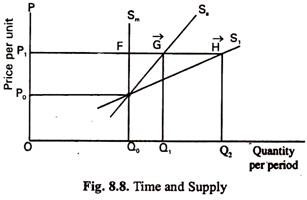The following nine points highlight the nine factors affecting price elasticity of supply.
Factor # 1. The Nature of the Industry:
The most important factor affecting price elasticity of supply in the nature of the industry under consideration.
This will indicate the extent to which production can be increased in response to an increase in the price of the product. If inputs (especially raw materials) can be easily found existing market prices, as in the textile industry, then output can be greatly increased if price rises slightly.
This means that supply is fairly elastic in the textile industry. On the other hand, if production capacity is severely limited, as in gold mines, then even a very large increase in price of gold will lead to a very small increase in production. This means that the supply of gold is fairly inelastic.
Factor # 2. Nature Constraints:
ADVERTISEMENTS:
The nature world also places restrictions upon supply. Rubber trees, for example, take 15 years to grow. So it is not possible to increase the supply of rubber overnight.
Factor # 3. Risk-Taking:
The willingness of entrepreneurs to take risks also affects price elasticity of supply. This, in its turn, depends on the system of incentives and disincentives. If, for example, the marginal rates of tax are very high, a price rise will not evoke much response among producers.
Factor # 4. The Nature of the Good:
As with demand elasticity, the most important determinant of elasticity of supply is the availability of substitutes. In the context of supply, substitute goods are those to which factors of production can most easily be transferred.
For example, a farmer can easily move from growing wheat to producing jute. Of course, mobility of factors is very important for such substitution. As a general rule, the more easily factors can be transferred from the production of one good to that of another, the greater the elasticity of supply.
Factor # 5. The Definition of the Commodity:
ADVERTISEMENTS:
As in the case of demand, elasticity of supply also depends on the definition of the commodity. The narrowly a commodity is defined, the greater its elasticity of supply. For example, it is easier for a tailor to transfer resources from producing red skirts to green skirts than from skirts to men’s trousers.
Factor # 6. Time:
Time also exerts considerable influence on the elasticity of supply. Supply is more elastic in the long run than in the short run. The reason is easy to find out. The longer the time period the easier it is to shift resources among products, following a change in their relative prices.
As Paul Samuelson has commented, “A given change in price tends to have a larger effect on amount supplied” as suppliers get more time to respond to price changes. Business firms may find it difficult to increase their usage of labour and output immediately after price rise. So supply is likely to be less elastic.
However, with the passage of time, business firms can hire more labour, capital and set up new factories so as to expand production capacity. Thus supply will increase considerably. So supply will be more elastic in the long run than in the short run because producers take some time to adjust their capacity to changes in demand.
ADVERTISEMENTS:
Alfred Marshall referred to three time period in this context, viz., the momentary period, the short-run and the long-run. In the momentary period supply is fixed and Es is zero. In the short run, supply can be varied by using existing machines and factories more intensively. In the long run firms can enter or leave the industry. Fig. 8.8 shows three supply curves for the three time periods.
A simple example will make the point clear. Suppose the demand for candles increases in Calcutta as a result of constant power failure. In the momentary period we have only whatever stocks of candles already exist in shops. Thus if price rises from P0 to P1 the same quantity will be offered for sale. In the short run the existing candle factories can work longer hours and hire additional workers.
So the quantity supplied will increase from Q0 to Q1 when price rises. If power failure continues in the long run, the increase in demand for candles will also be of a permanent nature. Consequently more candle factories are likely to be built in the long run, in which case the quantity supplied will increase from Q0 to Q2 when the price rises. Thus it seems that the supply curve rotates clockwise with the passage of time. It becomes more and more elastic.
Factor # 7. The Cost of Attracting Resources:
If supply is to be increased it is necessary to attract resources from other industries. This usually involves raising the prices of these resources. As their prices rise, cost of production also increases. So supply becomes relatively inelastic. If these resources can be obtained cheaply then supply is likely to be relatively elastic. These considerations become very important at times of full employment when the only available factors of production are those which can be attached from other industries and uses.
Factor # 8. The Level of Price:
Elasticity of supply is also likely to vary at different prices. Thus when the price of a commodity is relatively high, the producers are likely to be supplying near the limits of their capacity and would, therefore, be unable to make much response to a still higher price. When the price is relatively low, however, producers may well have surplus capacity which a higher price would induce them to use.
Factor # 9. Factor Mobility:
The ease with which factors of production can be moved from one use to another will affect price elasticity of supply. The higher the mobility of factor services, the greater will be elasticity.
